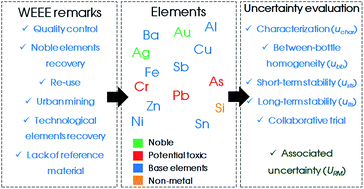Proposition of electronic waste as a reference material – part 2: homogeneity, stability, characterization, and uncertainties†
Abstract
In many cases involving the management of technological materials, such as electronic waste, characterization is performed to determine the precise elemental composition, as well as to detect harmful elements and substances. However, this is hampered by the lack of suitable reference materials for electronic waste. In the present study, a newly developed reference material for electronic waste according to the requirements imposed by ISO Guides 30–35 is discussed. Homogeneity, stability and characterization studies were performed using microwave-assisted acid leaching (aqua regia 50% v/v) and inductively coupled plasma optical emission spectrometry (ICP OES) for determination of Ag, Al, As, Au, Ba, Cr, Cu, Fe, Ni, Pb, Sb, Si, Sn, and Zn. One-way analysis of variance (ANOVA) at the 95% confidence level and linear regression were used as statistical parameters to obtain the uncertainty contributions to characterization (uchar), between-bottle homogeneity (ubb), and short-term (usts) and long-term (ults) stability tests. The results from the collaborative trial allowed the estimated mass fraction and associated uncertainty (URM) to be obtained for each element monitored.



 Please wait while we load your content...
Please wait while we load your content...